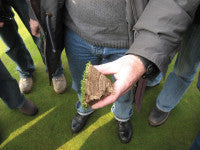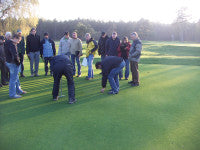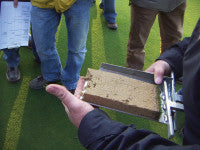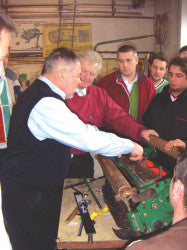Crossing the divide
 Two years ago Megan Hood left her native New Zealand to join the STRI to work as a regional agronomist in the North of England. Now she is heading back to take up a senior position with the New Zealand Sports Turf Institute.
Two years ago Megan Hood left her native New Zealand to join the STRI to work as a regional agronomist in the North of England. Now she is heading back to take up a senior position with the New Zealand Sports Turf Institute.
In her 'farewell' article she looks at how agronomy is approached in the UK and New Zealand and how the industry should be moving forward in both countries
While exposing yourself to a different culture will always leave an impression, my time in the UK has definitely changed the way I think about agronomy. It has also helped me to shape my opinion on where the industry should be moving in both New Zealand and the UK.
Agronomy
In agronomic terms the conditions that I have encountered in the UK are very similar to New Zealand. Fundamental issues, such as thatch management, drainage, surface preparation and species composition, are the main priority for greenkeepers in both countries.
I expected to encounter far more agronomic differences than I did. Despite the growing season being shorter and the soils less fertile in the UK than in New Zealand, the species composition and major turf issues are very similar. This has helped me come to the realisation that greenkeeping operations are often more influential on species composition than the climatic conditions or soil type.
Drainage
Like the UK, many older New Zealand golf courses have drainage issues. In New Zealand the trend has been towards reconstruction as drainage systems have not always been effective or have been too disruptive to surfaces. The Brits, however, have the pipe draining of greens down to a fine art. I have seen many fine examples of beautifully designed greens saved from reconstruction by the installation of the closely spaced pipe drainage systems. These systems are quick and inexpensive to install and disruption to play is minimal. Perfect! We have been experimenting with all sorts of other technology in New Zealand. However, in my opinion, none come close to the well-designed pipe drainage systems that I have seen in the UK.
Thatch Management
The approach to thatch management is similar in the UK to New Zealand, however, the monitoring of organic carbon levels is much more common in New Zealand. Most higher quality New Zealand clubs monitor their thatch levels at four different depths every six months (I always use 'loss on ignition tests'). This inexpensive testing (which is available in the UK) helps greenkeepers to assess the progress of thatch management programmes and also to communicate the ongoing need for operations such as topdressing and hollow-tine coring to members.
Equipment
The use of bulk-topdressing units is more widespread in the UK and has greatly improved the efficiency of topdressing here. This technology is yet to make a big impact in New Zealand, however, I don't think it will be long until they catch on to these handy tools.
Turf rollers (including vibratory rollers) have been widely used in New Zealand for quite some now and many UK clubs have taken on the technology during my time here. Certainly we are in a golden age of turf machinery and it is good to see that greenkeepers in both countries are making the most of the new technology.
Etiquette
When I came to the UK I thought that etiquette would be a priority on their golf courses. Oh, how wrong I was! Noticeably fewer people carry in the UK, and there seems to be a plague of electric buggies and trolleys on the courses. I know that there are legal reasons why clubs allow them on courses, but that doesn't stop me hating them. I find it especially amusing that players who have a medical certificate for a trolley can miraculously be cured once the 'carrying only' sign goes up.
Like the UK, New Zealand clubs also have issues with getting players to correctly repair pitch marks. I don't purport to have any new radical solutions to this problem other than a ceremonial dunking in the irrigation pond for culprits. Some of my UK clients have come up with some novel ideas though, which include:
• Putting a golf ball on every pitch mark on a badly affected green and taking a photo for members to see how many there are.
• Put the pin in the middle of an area with lots of pitch marks that haven't been repaired (I like that one).
• Install a CCTV camera on the par 3s to identify golfers that don't repair their marks so that they can be named and shamed (only the Brits could come up with that).
Personally, I still think that good mentoring of young or new golfers is vital. The USGA have a handy DVD that has an animated movie of how to correctly repair pitch marks and why they need to be repaired. I think that the more golfers are aware of the effects of poor pitch mark repair, the more they are likely to repair them.
Chemicals
The UK has far fewer chemicals available on the turf market than their NZ counterparts. Several chemicals recently released on the UK market have been available for several years in Australasia. This can be useful to the UK greenkeepers as they can draw upon the experience of their colleagues 'down under' with regard to how best to use them as turf conditions are pretty similar.
When I came to the UK, there were no growth regulator to use on greens. In Australasia we had significant experience of these products so, when PrimoMaxx came onto the market, I was able to explain the practical implications that we had experienced in New Zealand.
New Zealand's greenkeepers have some handy tools available that I am sure UK greenkeepers would love to have, such as the growth regulator that prevents seedheads and another that removes all other grasses from fine fescues. Perhaps these products will eventually come to market here and, if so, the New Zealand experience will be of reassurance to British greenkeepers.

Green Establishment
The establishment of greens on existing courses is an area where I think the Kiwis definitely have the upper hand. The New Zealand industry has moved away from traditional turfing and seeding. The problems with introducing a thatch layer and 'seaming' associated with turfing means that it is not an ideal approach.
Seeding new greens can also result in a new green that is totally different in appearance, performance and maintenance to the other greens on the course. Hence, New Zealand greenkeepers now use micro-tine cores from their best greens to establish the new surfaces. These are then overseeded with the fine grasses (hydro-seeding is best).
The greenkeepers have perfected this technique and some of the country's finest golf courses now use this method as establishment is rapid and the long-term results very good. Several golf courses in the UK have trialled the technique in the past few years with very good results
Education
A glaring difference between New Zealand and the UK is the approach to greenkeeper education. In New Zealand there is a single education institution for all turf sectors (golf, bowls, cricket, horse racing etc). In 2006, nearly 80% of all NZ greenkeepers (including crew and unpaid volunteers) had professional turf qualifications. This included 87 greenkeepers who hold a Bachelor's degree. Greenkeepers can do anything from a one-day course to a pHD whilst sta ying in a single system.
ying in a single system.
The New Zealand apprenticeship scheme is supported by central Government and a three year apprenticeship is the standard for greenkeepers. In some cases the government will also subsidise the greenkeeper's wages.
During their apprenticeship, the students learn about managing all types of turf surfaces, which extends their employment opportunities. After completing the apprenticeship, greenkeepers are encouraged to continue formal learning, which may entail a diploma or degree etc. Because turf education is organised through a single body, it is much easier to control the quality of teaching and to rapidly change the system and curriculum to suit the changing market conditions.
The high level of education means that greenkeepers are viewed as professionals and can demand a higher rate of pay and respect within the industry (which moves me onto my next point!).
Perception of Greenkeepers
I wasn't long in the industry when I noticed a difference in the perception of greenkeepers between New Zealand and the UK. I had heard about greenkeepers being perceived as 'grass cutters' before, but not on the scale that I have observed in the UK. From speaking to 'more mature' greenkeepers in New Zealand, it apparently used to be the same way there. Around 15 years ago, the New Zealand industry realised that nobody wanted to be a greenkeeper anymore. It had become difficult to attract young people to the industry as the profession was not respected and pay and conditions were poor.
The New Zealand Greenkeepers Association set out to actively promote greenkeeping as a true profession. The new generation of motivated greenkeepers looked towards America for a new name and a new role. After much debate, they changed their title to Superintendents as they felt that the perception of greenkeepers was of 'old chaps in a cloth cap mowing a bowling green'.
But a name change alone was not going to achieve much. The New Zealand Golf Superintendents Association (NZGSA), as it was now known, played an active role within the turf institute and the Industry Training Organisation.
The NZGSA promoted the value of education and many greenkeepers retrained to bring their technical, business and communication skills up to date. As the greenkeepers became more educated, they communicated more effectively and took on greater management responsibilities.
A reality TV series was screened that revolved around life working one of the top golf courses (including the two young women working on the crew), which also helped to promote greenkeeping as a desirable profession.
The industry as a whole became more highly respected within their clubs and, with this respect, came improved wages and working conditions.
Agronomy Visits and the role of the STRI
The way agronomy visits work over here is totally different to New Zealand and this affects the role of the agronomist. The New Zealand Sports Turf Institute (NZSTI) is industry-owned and managed. New Zealand Golf and the Superintendent's Association both play an active role on the NZSTI board of management and provide input into the strategic direction of the organisation.
The NZSTI receives levy funding from New Zealand Golf and every golf course (no matter how rich or poor) receives at least one agronomy visit each year from an NZSTI agronomist.
 In New Zealand agronomy visits typically involve a one-on-one course walk and meeting with the Superintendent. Reports usually focus on providing additional information requested by the greenkeeper and brief minutes of the visit. The role of the agronomist is as an advisor to the Head Greenkeeper, helping him or her to make informed decisions and to set goals for the management of the course. They are used as a resource to find further information or as a sounding board for new ideas.
In New Zealand agronomy visits typically involve a one-on-one course walk and meeting with the Superintendent. Reports usually focus on providing additional information requested by the greenkeeper and brief minutes of the visit. The role of the agronomist is as an advisor to the Head Greenkeeper, helping him or her to make informed decisions and to set goals for the management of the course. They are used as a resource to find further information or as a sounding board for new ideas.
In the UK the situation is very different. Firstly, there is no levy system so often the clubs that really need help can't afford it. When the agronomist arrives for an agronomy visit he or she is typically greeted by a squad of golfers and Committee members (plus the greenkeeper when invited). My record so far is ten people on a course walk and, yes, I have had visits where the greenkeeper was not invited!
To begin with, I wasn't quite sure of what to make of this different approach. I certainly find more time is spent explaining basic turf principles to the lay-men and it can be difficult to keep everyone present focussed on the main issues at hand. Whilst the agronomist's role is still to advise the greenkeeper, there is also the situation where turf issues have to be related back to the club; in New Zealand this, generally, is the role of the greenkeeper.
Here, the club are only usually involved in a visit if the course policies or strategic goals are discussed (or if there is a big problem!). I feel that clubs in New Zealand are much more likely to view the greenkeeper as a paid professional whose judgement is to be trusted. In the UK there is certainly more questioning of the greenkeeper's judgement.
Where are the women?
One of the interesting differences in the UK is that there a very few women in the industry here. In New Zealand the number of women in the industry has increased over the past fifteen years, with women working their way into senior positions at a growing number of clubs. Whilst women are still significantly under-represented compared to the general population, in 2006 there were 180 female greenkeepers in New Zealand. It also appears that the number of women attending entry-level courses and taking up apprencticeships is also on the increase.
One of my STRI colleagues visited New Zealand recently and was surprised to encounter a top club that had five women on the crew. Another club in the South Island has a trans-gender greenkeeper. It is difficult to pin-point the reason why women have not moved into the turf industry in the UK, although it is worth acknowledging that the Industry Training Organisation has actively targeted females in some of their marketing.
The Disturbance Theory
The Disturbance Theory has received growing interest in both the UK and New Zealand. Henry Bechelet, who developed the theory with Richard Windows, visited New Zealand earlier this year only to find that lots of the greenkeepers there had read their articles. I think that all greenkeepers want to have a greater understanding on the way grasses grow and how they perform.
Henry and Richard bring more science into the arena than most greenkeepers are usually used to, but they have done it in a way that is very appealing and common-sense. It was pleasing to see that the New Zealand greenkeepers had taken the knowledge provided by the theories and applied the principles to their own situations. The UK are definitely leading the charge with regard to the finer grasses, however the Kiwis have been quick to cotton on and it will be interesting to see what they come up with.
I was fortunate enough to travel the UK with both Richard and Henry earlier this year to take part in their Disturbance Theory seminars. This provided the opportunity to sit down and discuss the bare basics of how we think about greenkeeping and to explore our approach to agronomy and greenkeeping. It highlighted to me the value of sharing ideas on a regular basis. At BTME greenkeepers from around the world joined in the discussion and shared their ideas with us.
No single person, organisation, or even country can come up with the perfect formula for greenkeeping. To truly progress we need to keep talking to each other and to challenge common thinking. I hope that in the future the greenkeepers and agronomists from the UK and New Zealand will continue to exchange ideas in order to continue to improve the greenkeeping practices in both countries.
